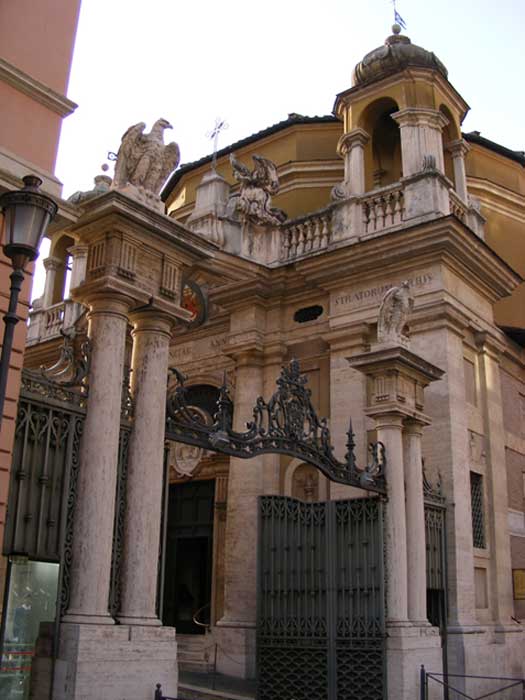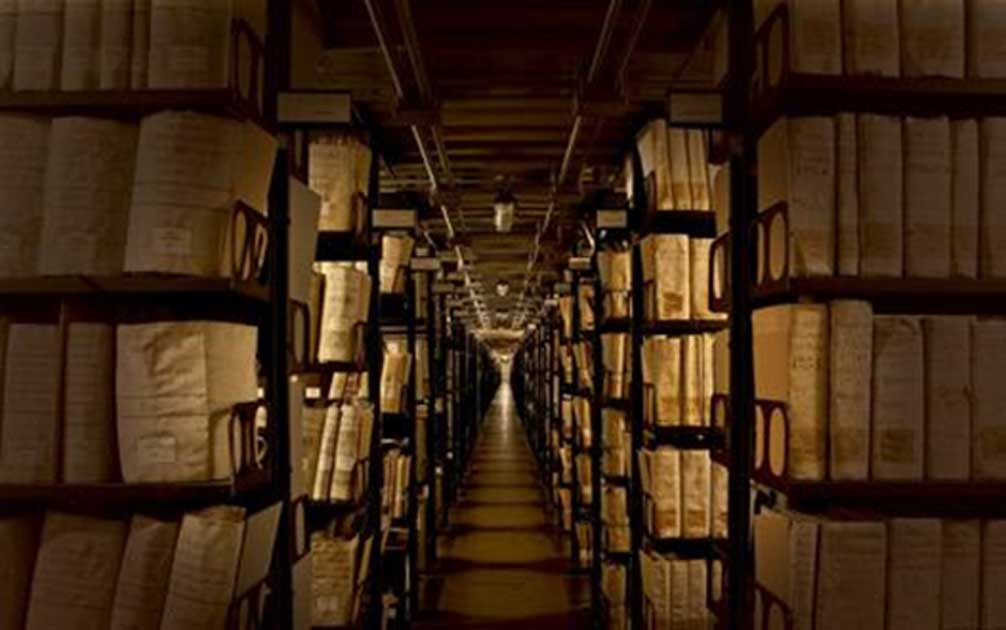What Really Lies Hidden in the Vatican Secret Archives?
Mystery and intrigue are inherent to the Holy See. People will always wonder what religious authorities are conspiring to behind closed doors, what treasures lie within the vaults of the Vatican. Despite claims that the Pope has evidence of extraterrestrials and demons tucked away in his catacombs, the truth of the secret archives is much more realistic. Because of this, it is also much more interesting.
From handwritten letters of historic personages such as Mary Queen of Scots and Abraham Lincoln to papal bulls excommunicating Martin Luther, the contents of the archives are enough to make any scholar’s eyes go wide. Yet, the high-level nature that makes the contents so fascinating is also what makes them so closely guarded. For in truth, it is not evidence of aliens that the Vatican is hiding from the public eye but rather documents that may show the Church was complicit in Mussolini’s state-sponsored terror and, possibly, even in Hitler’s anti-Semitic pogroms.
Archivum Secretum
The truth behind the secret archives stems from a mistranslation of Latin. The actual name of the Vatican archives is Archivum Secretum Apostolicum Vaticanum. ‘Secretum’ in Latin does not mean ‘secret’ as some may suppose. It is more accurately translated to mean ‘personal’ or ‘private’. The archives are in fact made up of the private letters and historic records of past popes over the past four centuries.
The archives were established by Pope Paul V. The Pope clearly had a sense of the historic importance of papal correspondence and knew that such documents should be preserved. However, the 17th century was firmly of the mentality that common people should not be privy to words exchanged by kings and popes. So the archives were kept under lock and key.
- Vatican City: The Tiniest Country with the Biggest Influence
- How Old Are The Thousands Of Bones Discovered Beneath Vatican? 500 Years? 50, Possibly 5?
Accessing the Private Archives
It was not until 1881 that Pope Leo XIII allowed researchers to view some of the archive’s contents. However, it was no simple matter for one to view the documents and the procedure has not changed much over the last 200 years. First of all, journalists, students, and amateur historians are not given access.
Once an interested party has proven that he or she is a serious enough scholar, credentials are granted that must be renewed every six months. To enter the archives, a “scholars enter through the Porta Sant’Anna, pass Swiss Guards, walk through the Cortile del Belvedere, and present credentials” (O’Loughlin, 2014).

The Porta Sant Anna, where visitors must pass through to reach the archives. (Mattes/CC BY-SA 3.0)
Once admitted, scholars must request which specific documents they wish to review. They are only allowed to request three per day. So instead of being able to browse the contents of the archive, they must select articles from catalogs in which items are handwritten in Italian or Latin. These catalogs are quite imposing considering that the archives contain “50 miles [80km] of shelving and documents dating back to the eighth century” (Keyser, 2015).
“If in just a few minutes they realize that what they’re seeking isn’t in the requested folders, they’re forced to pack up for the day - a challenge for scholars on a deadline or those who have traveled long distances” (O’Loughlin, 2014). Computers are allowed but not photography, so scholars spend most of the sessions in reading rooms typing up notes.
The Vatican Archives Contain Historical Gems
If a person is fortunate enough to gain access to the Vatican Archives, he or she would be able to pursue such historical gems as:
- The 197-foot-long (60 meters) scroll containing the minutes of the trials of the Knights Templar, which lasted for several years starting in 1307.
- The Inter caetera, the papal bull issued by Pope Alexander VI in 1493 that split the world between the Spanish and the Portuguese
- A letter from Michelangelo to Pope Julius II
- The 1521 papal bull of Pope Leo X excommunicating Martin Luther
- The 1530 petition Henry VIII sent to Pope Clement VII in order to request an annulment of the king’s marriage to Catherine of Aragon, which includes the signatures and seals of over 80 English lords and clergymen (the Pope refused)
- A letter to Pope Sixtus V from Mary, Queen of Scots begging the Church to intervene shortly before her execution
- Notes relating to the 1633 trial against Galileo
- A letter to Pope Innocent X from Grand Empress Dowager Helena Wang of China
- A letter from Pope Clement XII to the Seventh Dalai Lama requesting protection for Franciscan missionaries in Tibet.
- Letters from both Abraham Lincoln and Jefferson Davis (both written in 1863, neither man Catholic) in efforts to have Pope Pius IX come down in favor of the Union or the Confederacy

A letter from King Henry VIII to Anne Boleyn, held in the Vatican archive. (public domain)
Pope Pius XII in League with the Nazis?
David Kertzer, a historian from Brown University, was able to examine documents from the reign of Pope Pius XII (1922 - 1939). He concluded that the pope “made deals with Mussolini to protect the Church’s interest in exchange for silence on state-sponsored anti-Semitism, a conclusion at odds with the Church’s account” (O’Loughlin, 2014). Groups pressured Pope Francis to make fully available the contents relating to Pope Pius XII (1939 - 1958) in order that the world may finally know for certain the man’s involvement with the Nazis.
Some say that he supported Hitler, either in a manner similar to the Church’s support of Mussolini or perhaps even more substantially. Others say that the Pope worked against the Nazis and helped to hide Jews and other targets of Nazi aggression. “People talk, scholars talk. Are there things that aren’t being made available because they’re seen as unflattering from a Church point of view?” said Kertzer. Still, Kertzer admits, the Secret Archives are staffed by professionals, and “there’s an appreciation of serious historical scholarship.” (O’Loughlin, 2014)
In March 2020, Pope Francis made “the fundamental documentation of Pius XII’s pontificate” available to historians, saying that that the church is “not afraid of history.” When researchers convened this year in a webinar to discuss their assessment of the archives so far they said, “it would likely take years to assess the material the Vatican has made available,” according to National Catholic Reporter.
Nonetheless, David Kertzer states, “I do not think there is going to be one smoking gun — in fact, I would despair of any evidence that's actually changing people’s minds these days.” However, Nina Valbousquet, a researcher at the Ecole Française de Rome, said that she found some Vatican correspondence from a time shortly after the war which suggests some officials had “a deep lack of understanding of what had happened during the Holocaust and harbored antisemitic sentiments.”
- Vatican Astronomers Join Search for Extra-Terrestrials
- No Girls Allowed? Debate for Women in the Christian Priesthood Rages On
Making the Archives A Little Less “Secret”?
In 2012, in celebration of the 400th anniversary of the archives, 100 documents were made available for the public to see in an exhibit called Lux in Arcana. However the tradition of only granting permission for about 1,000 scholars to access the archives in-person per year continues.

Lux in Arcana - The Vatican Secret Archives Reveals Itself. Credit: The Vatican
According to Pope Francis, the Vatican Archives are no longer ‘secret,’ instead they’re ‘apostolic.’ In 2019 he decided to change the centuries-old title of the Archivum Secretum Vaticanum, the Vatican Secret Archives, to the Vatican Apostolic Archives because, Vatican News reports, “in Latin both secretum (which means separate, private) and apostolicum (that is, belonging to the domnus apostolicus, who is only the pope) refer to the same reality, even juridical.”
The Pope made his decision based on the need to meet modern ‘sensibilities’, which often associate the word secretum with ideas of mysteries and hidden artifacts locked away in vaults.
Nevertheless, the Vatican Archives remain the Pope’s private archives – “subject to him alone and to his exclusive governance,” as Vatican News states.
Top image: Some of the 50 miles of bookshelves in the Vatican secret archive Photo: The Vatican
Updated on July 13, 2021.
References
The Guardian. "In Pictures: Secrets of the Vatican Archives." The Guardian. Guardian News and Media, 16 Sept. 2010. Web. https://www.theguardian.com/books/gallery/2010/sep/08/vatican-secret-archives-pope.
Keyser, Hannah. "15 Historic Wonders Housed in the Vatican's Secret Archives. " Mental Floss. Mental Floss, Inc., 15 May 2015. Web. http://mentalfloss.com/article/63850/15-historic-wonders-housed-vaticans-secret-archives.
O'Loughlin, Michael. "What's Hidden in the Vatican Secret Archives?" Crux. Crux Catholic Media Inc., 01 Sept. 2014. Web. https://cruxnow.com/church/2014/09/01/whats-hidden-in-the-vatican-archives/.


















Comments
There would be TWO THINGS found in the Vatican archives: 1) that which is hard, or impossible, to explain going by prevailing narratives; and 2) evidence of theft, alteration and forgery. Were somebody to finally be allowed to go in and do a wall-to-wall inventory, expect mostly the latter.
Nobody gets paid to tell the truth.
Researching the Papal archives would be helpful but not always needed. Looking through the regular historical record we’ve already seen the ‘Dirty-Little’ secrets of the Vatican from the persecution of the Templar order to the current & devastating child abuse at the hands of Catholic Clerics. The Catholic Church has certainly let itself be corrupted & poisoned by the Secular World.
As to Pius XII's deal with the Devil, oh, Mussolini; Pius probably thought that well if the Jews get persecuted they’ll just do what they’ve always done: move somewhere else better. What ever actions done to hurt or help Jews or Nazis the Pope just turned a ‘Blind Eye’.
What they don't want the general public to find out is that the bedrock of all major religions was a way more intelligent aliens could slowly guide the social development of the human race by manipulating the population.
I heard but don't know but that some of the scrolls from Library of Alexandria ended up in Vatican. Is this true?
So why are the information regarding the holly lance including the artifact itself left hidden
Pages